The routeFrom the Trent & Mersey main line at Etruria Junction, up to Hazelhurst Junction. The main line then descends to Cheddleton, down the River Churnet valley to Froghall. The branch line from Hazelhurst approaches Leek and stops at the Churnet aqueduct just short of the original terminus.
|
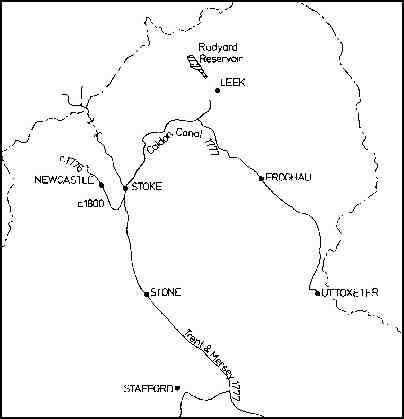 |
| From: | Etruria junction with the Trent & Mersey canal. |
| To: | Frogall (used to be to Uttoxeter but now derelict/built over by railway) |
| Distance | 17 miles |
| Junctions: | Branch to Leek (2 Miles) |
| Locks : | 17 inc Staircase Lock |
| Tunnels : | Froghall |
| Aquaducts: | Hazelhurst |
| Water Supply: | Three reservoirs feed this canal which was built as much for its value as a
water supply route for the Trent and Mersey canal as for its trade.
|
|
The famous potter Josiah Wedgwood was the driving force behind the construction of the TRENT & MERSEY Canal and its branch, the CALDON. Both these waterways revolutionised the transport of fragile porcelain, at a time when the normal mode of carriage was by mule and cart over rough tracks! Linking the POTTERIES to the
MERSEY ESTUARY by water also allowed the cheaper importation of China clay
from the West Country mines, thus bringing the ownership of fine china
within the means of the average Victorian family. |
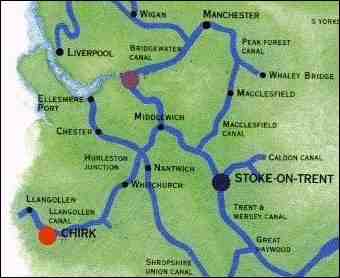 |
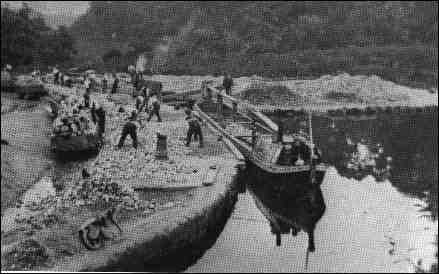 Loading limestone from Caldon Low |
|
| Once you get out of
Stoke-on-Trent, the Caldon becomes one of the most charming stretches of
canal in the country. The Canal splits into two arms at the end of the
main summit. The main arm goes down through three locks, seen here, and
then on to Consall Forge and Frogall. Just past this point, the main arm
passes underneath the other arm, which crosses it on an imposing aqueduct
and then winds its way to Leek.
The main arm goes through a lovely stretch once the River Churnett
joins it above Consall Forge and it winds through a heavily wooded valley.
Worth a visit and a walk even in the absence of a boat.
|
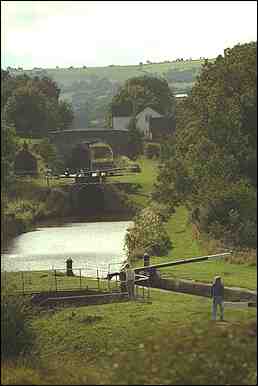 |
Cheddleton Flint Mill At Cheddleton there is a well-preserved flint mill, now a museum,
which has not one but two working water wheels driven by the River
Churnett, which later joins the Canal for its lower section until Consall
Forge.
|
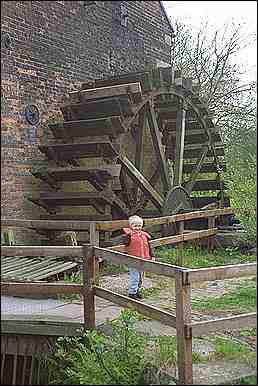 |
| The Caldon Canal
is really a branch of the Trent & Mersey Canal at Stoke-on-Trent, but
is little-known & much underrated for its beauty and dramatic views at
it winds its way into the countryside above the Potteries and through to
the Derbyshire hills. At one point the canal splits into two arms, one of
which crosses over the other shortly afterwards on a massive aqueduct. The
lower of those arms is joined by the River Churnet and drops down to the
Canal's terminus at Frogall, not all that far from Alton Towers, through a
beautifully peaceful wooded valley. The other takes the high road to Leek,
where it ends beside the now disused aquaduct short of the town.
The Caldon has much of interest, including a
well-preserved flint mill and pair of working water wheels at Cheddleton,
a pub completely isolated from the roads at Consall Forge, and a very
small tunnel at Frogall navigable only by the narrowest and lowest of
narrowboats. Since we used to have RR moored at Stoke-on-Trent we got to
know the Caldon very well.
|
|
|
A number of these venerable old buildings remain, still producing fine china, although the strangely shaped 'Bottle Kilns' which once fired the clay are no longer used, but thankfully preserved. The restored canals still pass their door, now allowing us a privileged insight into Victorian working life so graphically illustrated with the pages of Arnold Bennett’s classic book ANNA OF THE FIVE TOWNS. It's not all potteries and towns though, far from it! The Caldon Canal leaves the Potteries and, taking a north easterly course, climbs into the STAFFORDSHIRE PEAKS to descend the CHURNET VALLEY through an area so remote and peaceful that it has earned the title 'Staffordshire's Little Switzerland.' One pub, at CONSALL FORGE, is so cut off, that the only means of access is by water or four wheel drive vehicle
|
|
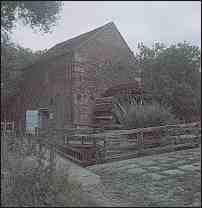 |
Restored
flint mill with two water wheels. Museum collection includes 100hp steam
engine and horse drawn canal boat on Caldon Canal.
OPEN: Cheddleton Leek TEL: 01538 392561
|
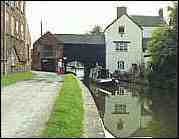
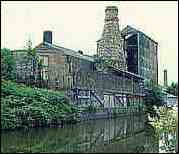 |
Mills
and other Industrial Buildings Canals were created to serve the needs of the rapidly developing industrial revolution, and industry continued to develop alongside the canal system. So industrial buildings were very common alongside canals, although recent redevelopment has has often removed many traces, as in the Birmingham area. In the Potteries alongside the Trent and Mersey Canal you can still see old bottle kilns, used for firing pottery, as on the left. Mills, like the one at Cheddleton on the Caldon Canal on the right, were often using river water for power well before the canal came to use the river's route. |
| Swing
and lift bridges Movable bridges were usually cheaper to build than fixed bridges because they didn't require the same heavy foundations and structure. Canals which were short of construction money often used lift bridges, as on the Oxford Canal and on the Llangollen Canal on the right. Lift bridges were counter-weighted and usually operated manually or by using a windlass. Swing bridges are common on a number of canals |
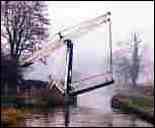 |
![]()
If you want to print this page out then set the print to landscape.
![]()
![]()
[ Comments / Questions? email: Steven
Birks ]